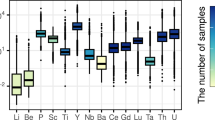Abstract
Spinel group minerals, found within various rock types, exhibit distinct categorizations based on their host rocks. According to Barnes and Roeder (2001), these minerals can be classified into eight primary groups, each further subdivided into variable numbers of subgroups that can be related to a particular tectonic setting. This classification is based on the cations corresponding to the end-members of the spinel prism and is traditionally analyzed in this prismatic space or using projections of it. In this prismatic representation, several categories tend to overlap, making it impossible to determine which is the tectonic environment in that scenario. An alternative to solve this problem is to generate representations of these groups considering more attributes, making the most of the many values measured during the geochemical analysis. In this paper, we present SpinelVA, a visual exploration tool that integrates Machine Learning techniques and allows the identification of groups using the cations considered by Barnes and Roeder and some additional ones obtained from chemical analysis. SpinelVA allows us to know the tectonic environment of unknown samples by categorizing them according to the Barnes and Roeder classification. Additionally, SpinelVA integrates a collection of visual analysis techniques alongside the already used spinel prism projections and provides a set of interactions that assist geologists in the exploration process. Users can perform a complete data analysis by combining the proposed techniques and associated interactions.






Similar content being viewed by others
Availability of Data and Material
The data is available for download at the link: https://github.com/visualprojects/spinelVA
Code Availability
The application can be freely accessed at the website https://icic.uns.edu.ar/geoviz/ from any browser.
References
Abre P, Cingolani C, Zimmermann U et al (2009) Detrital chromian spinels from upper ordovician deposits in the Precordillera Terrane, Argentina: a mafic crust input. J S Am Earth Sci 28(4):407–418. https://doi.org/10.1016/j.jsames.2009.04.005
Antonini AS, Ganuza ML, Ferracutti G et al (2021) Spinel web: an interactive web application for visualizing the chemical composition of spinel group minerals. Earth Sci Inf 14(1):521–528. https://doi.org/10.1007/s12145-020-00542-w
Barnes S, Roeder P (2001) The range of spinel compositions in terrestrial mafic and ultramafic rocks. J Petrol 42:2279–2302. https://doi.org/10.1093/petrology/42.12.2279
Box GE, Cox DR (1964) An analysis of transformations. J R Stat Soc Ser B Stat Methodol 26(2):211–243. https://doi.org/10.1111/j.2517-6161.1964.tb00553.x
Breiman L (1996) Bagging predictors. Mach Learn 24:123–140
Breiman L (2001) Random forests. Mach Learn 45:5–32
Chawla NV, Bowyer KW, Hall LO et al (2002) Smote: synthetic minority over-sampling technique. Journal of artificial intelligence research 16:321–357. https://doi.org/10.1613/jair.953
Engle MA, Chaput J (2023) Visualizing high dimensional structures in geochemical datasets using a combined compositional data analysis and databionic swarm approach. Int J Coal Geol 275:104303
Ferracutti GR, Gargiulo MF, Ganuza ML et al (2015) Determination of the spinel group end-members based on electron microprobe analyses. Mineral Petrol 109(2):153–160. https://doi.org/10.1007/s00710-014-0363-1
Ganuza ML, Castro SM, Ferracutti G et al (2012) Spinelviz: an interactive 3d application for visualizing spinel group minerals. Comput Geosci 48:50–56. https://doi.org/10.1016/j.cageo.2012.05.003
Ganuza ML, Ferracutti G, Gargiulo MF et al (2014) The spinel explorer–interactive visual analysis of spinel group minerals. IEEE Trans Visual Comput Graphics 20(12):1913–1922. https://doi.org/10.1109/TVCG.2014.2346754
Ganuza ML, Gargiulo F, Ferracutti G et al (2015) Interactive semi-automatic categorization for spinel group minerals. In: IEEE Conference on visual analytics science and technology (VAST), pp 197–198, https://doi.org/10.1109/VAST.2015.7347676
Ganuza ML, Ferracutti G, Gargiulo MF et al (2017) Interactive visual categorization of spinel-group minerals. In: Proceedings of the 33rd spring conference on computer graphics, ACM, pp 1–11. https://doi.org/10.1145/3154353.3154359
Griparis A, Faur D, Datcu M (2016) Dimensionality reduction for visual data mining of earth observation archives. IEEE Geosci Remote Sens Lett 13(11):1701–1705
He H, Bai Y, Garcia EA, et al (2008) Adasyn: adaptive synthetic sampling approach for imbalanced learning. In: 2008 IEEE International joint conference on neural networks (IEEE world congress on computational intelligence), pp 1322–1328. https://doi.org/10.1109/IJCNN.2008.4633969
Lindsay JJ, Hughes HS, Yeomans CM et al (2021) A machine learning approach for regional geochemical data: platinum-group element geochemistry vs geodynamic settings of the North Atlantic Igneous province. Geosci Front 12(3):101098
McInnes L, Healy J (2018) Umap: uniform manifold approximation and projection for dimension reduction. https://doi.org/10.21105/joss.00861
Petrelli M (2023) Machine Learning for Earth Sciences. Springer
Torgerson WS (1952) Multidimensional scaling: I. theory and method. Psychometrika 17:401–419. https://doi.org/10.1007/BF02288916
Trott M, Leybourne M, Hall L et al (2022) Random forest rock type classification with integration of geochemical and photographic data. Appl Comput Geosci 15:100090
Van der Maaten L, Hinton G (2008) Visualizing data using t-sne. J Mach Learn Res 9(11)
Wang Y, Qiu K, Telea A, et al (2023) Interpreting machine learning models for geochemistry data classification using decision boundary maps. In: EGU General assembly conference abstracts, pp EGU–10228
Wenskovitch J, Crandell I, Ramakrishnan N et al (2017) Towards a systematic combination of dimension reduction and clustering in visual analytics. IEEE Trans Visual Comput Graphics 24(1):131–141
**a J, Huang L, Lin W et al (2022) Interactive visual cluster analysis by contrastive dimensionality reduction. IEEE Trans Visual Comput Graphics 29(1):734–744
Yeo IK, Johnson RA (2000) A new family of power transformations to improve normality or symmetry. Biometrika 87(4):954–959. https://doi.org/10.1093/biomet/87.4.954
Zuo R, **ong Y (2018) Big data analytics of identifying geochemical anomalies supported by machine learning methods. Nat Resour Res 27:5–13
Funding
This work was partially supported by PGI 24/N048 and PGI 24/ZN38 research grants from the SecretarÃa General de Ciencia y TecnologÃa, Universidad Nacional del Sur (Argentina), and by 28720210100824CO (PIBAA) granted by National Council for Scientific and Technical Research (CONICET).
Author information
Authors and Affiliations
Corresponding author
Ethics declarations
Conflicts of Interest
The authors declare that they have no conflict of interest.
Additional information
Communicated by: H. Babaie.
Publisher's Note
Springer Nature remains neutral with regard to jurisdictional claims in published maps and institutional affiliations.
Rights and permissions
Springer Nature or its licensor (e.g. a society or other partner) holds exclusive rights to this article under a publishing agreement with the author(s) or other rightsholder(s); author self-archiving of the accepted manuscript version of this article is solely governed by the terms of such publishing agreement and applicable law.
About this article
Cite this article
Antonini, A.S., Luque, L., Ferracutti, G.R. et al. SpinelVA. A new perspective for the visual analysis and classification of spinel group minerals. Earth Sci Inform (2024). https://doi.org/10.1007/s12145-024-01393-5
Received:
Accepted:
Published:
DOI: https://doi.org/10.1007/s12145-024-01393-5




